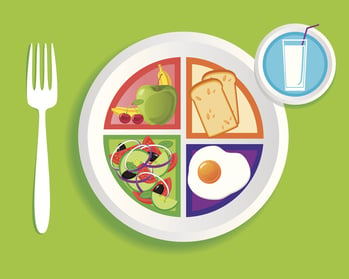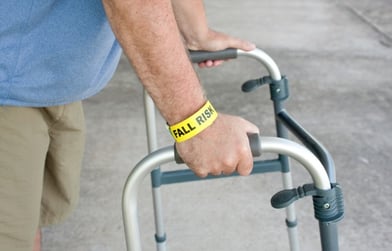 Some people think that snacking can sabotage your healthy eating plan. However, snacking keeps your energy levels up and prevents you from becoming overly hungry, which can lead to poor food choices. Eating every three to four hours can also help regulate your metabolism, which ensures that you burn calories throughout the day. Strive for at least two small snacks per day, but try to limit yourself to 100 to 150 calories or less per snack.
Some people think that snacking can sabotage your healthy eating plan. However, snacking keeps your energy levels up and prevents you from becoming overly hungry, which can lead to poor food choices. Eating every three to four hours can also help regulate your metabolism, which ensures that you burn calories throughout the day. Strive for at least two small snacks per day, but try to limit yourself to 100 to 150 calories or less per snack.
Also, be sure your snack is balanced—that it offers complex carbohydrates for energy, protein for muscle building and repair, and a small amount of fat for satiety. You can ensure nutritional balance and prevent snack boredom by varying your daily choices.
Best Snacks for Great Nutrition
Here are some great snack choices:
- 6 oz Greek yogurt topped with ½ cup of berries
- ¾ cup of whole-grain cereal, nut, and dried fruit trail mix
- 1 apple and 1 oz. low-fat cheese
- 1 cup yogurt smoothie made with real fruit
- 1 oz. baked tortilla chips with ¼ cup bean dip
- 2 oz. low-fat cheese on five whole-grain crackers
- 1 whole-wheat tortilla with 1 oz. melted cheese and ¼ cup salsa
- 1 cup raw vegetables and 2 Tbsp. low-fat dip or hummus
- 1 Tbsp. nut butter on a banana
- 1 cup berries topped with ¼ cup low-fat granola cereal
- ¼ cup whole-grain cereal and ¼ cup raisins with ¼ cup skim milk
- ¾ cup pasta salad made with raw veggies, cheese, and low-fat dressing
- ½ pita pocket stuffed with raw vegetables and 1 slice low-fat cheese
- 1 cup low-fat vegetable-bean soup
- ½ turkey and cheese sandwich on whole-wheat bread
- 1 handful almonds and ¼ cup dried cranberries
- ½ cup cottage cheese and ½ cup pineapple
- ½ peanut butter/banana sandwich on whole-wheat bread
- ½ whole-wheat English muffin toasted and topped with a slice of tomato and low-fat cheese
The Benefits of Snacks
You might feel guilty about snacking, but snacks aren’t necessarily bad. In fact, mini meals several times a day can be beneficial. Here’s how:
- Binge control. If eating several low-fat, whole-grain crackers, a few pretzels, a piece of fruit, or some raw vegetables keeps you from taking second or third helpings at your next meal, you may actually consume fewer total calories for the day.
- Extra energy and nutrients. Traditional, made-at-home meals often lose out to busy schedules. A grab-and-go snack can be the difference between some nourishment and none at all.
- Satisfaction for small appetites. Young children’s tiny stomachs can hold only small portionsof food at a time. Older adults who are less active and who burn fewer calories also may feel comfortable eating smaller meals more frequently.


 We see it, we eat it. Usually that’s how it goes, right? Of course we eat too much, but is it really our faults? Well, unfortunately for Americans, the portion distortion mania has gotten out of hand—and so has obesity. Over time, we’ve gotten so used to the larger portions being served at restaurants, we’ve come to think this is normal. Then of course that thinking spills over into a food addiction at home, too. More food, more food, more food. The craziness needs to stop now! (Here are
We see it, we eat it. Usually that’s how it goes, right? Of course we eat too much, but is it really our faults? Well, unfortunately for Americans, the portion distortion mania has gotten out of hand—and so has obesity. Over time, we’ve gotten so used to the larger portions being served at restaurants, we’ve come to think this is normal. Then of course that thinking spills over into a food addiction at home, too. More food, more food, more food. The craziness needs to stop now! (Here are 
 Obesity is an epidemic in our society today. Those who are obese have greater risk of diabetes, coronary artery disease, stroke, and arthritis.
Obesity is an epidemic in our society today. Those who are obese have greater risk of diabetes, coronary artery disease, stroke, and arthritis.
 One of my favorite holiday traditions is making fabulous treats for friends, family, co-workers, and neighbors. Entire days are spent baking in the kitchen and the best part (after sampling the treats first hand) is hearing how great everything tastes. Little do they know that with just a few simple tweaks, those holiday cookies and candy can be dramatically lower in fat and calories. Here are a few easy substitutions to try:
One of my favorite holiday traditions is making fabulous treats for friends, family, co-workers, and neighbors. Entire days are spent baking in the kitchen and the best part (after sampling the treats first hand) is hearing how great everything tastes. Little do they know that with just a few simple tweaks, those holiday cookies and candy can be dramatically lower in fat and calories. Here are a few easy substitutions to try: Body Mass Index (BMI) vs. Body Composition: These measurements are used in the healthcare and corporate fitness worlds to help identify risk for heart disease, diabetes, stroke, and cancer. But which is best? Many experts reason that both tools can be useful in different circumstances.
Body Mass Index (BMI) vs. Body Composition: These measurements are used in the healthcare and corporate fitness worlds to help identify risk for heart disease, diabetes, stroke, and cancer. But which is best? Many experts reason that both tools can be useful in different circumstances.
 Slow and steady. These are the two words that participants in the Pound Plunge, Richmond Wellness Center’s weight-loss contest, frequently hear from me as I coach them through eight weeks of total body transformation. To the dismay of many, weight loss is not an instant process. Many wish they could achieve their ideal weight in only a couple of days, but
Slow and steady. These are the two words that participants in the Pound Plunge, Richmond Wellness Center’s weight-loss contest, frequently hear from me as I coach them through eight weeks of total body transformation. To the dismay of many, weight loss is not an instant process. Many wish they could achieve their ideal weight in only a couple of days, but  Many people feel that drinking diet sodas is a healthy alternative to regular sodas. While we may believe artificially sweetened beverages may help cut daily calorie intake and therefore minimize weight gain or aid in loss, there is evidence that they can put employee health in danger.
Many people feel that drinking diet sodas is a healthy alternative to regular sodas. While we may believe artificially sweetened beverages may help cut daily calorie intake and therefore minimize weight gain or aid in loss, there is evidence that they can put employee health in danger. I love what I do. Seeing people succeed with their weight-loss goals is one of the most rewarding feelings as a dietitian. However, it can also be very challenging when I see clients revert back to old habits and struggle to keep off the weight that they worked so hard to remove.
I love what I do. Seeing people succeed with their weight-loss goals is one of the most rewarding feelings as a dietitian. However, it can also be very challenging when I see clients revert back to old habits and struggle to keep off the weight that they worked so hard to remove. This blog was written by Anna Hiple. Meet our blogging fitness specialists at the
This blog was written by Anna Hiple. Meet our blogging fitness specialists at the  Aim to eat a 150 to 300-calorie snack with a mix of carbs, protein, and healthy fats in between meals. Most likely, this will average out to eating approximately every two to three hours. Consistently fueling your body provides a boost to your metabolism and prevents the overeating that can happen all too easily when you approach a meal with an empty stomach.
Aim to eat a 150 to 300-calorie snack with a mix of carbs, protein, and healthy fats in between meals. Most likely, this will average out to eating approximately every two to three hours. Consistently fueling your body provides a boost to your metabolism and prevents the overeating that can happen all too easily when you approach a meal with an empty stomach.